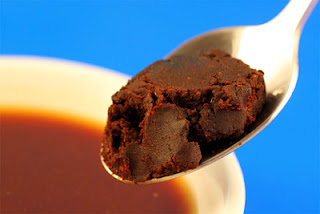 |
| Different types of miso www.cookingforhealth.biz |
It contains living enzymes which aid digestion, beneficial bacteria essential for enhancing gut flora and digestive health, and provides a nutritious balance of natural carbohydrates, essential fatty acids, vitamins, minerals and proteins.
Miso also contains phytonutrients in the form of soy isoflavones, including genistein and daidzein, which are known to be protective against cancer.
The most typical miso is made with soy. The typical result is a thick paste used for sauces and spreads, pickling vegetables or meats, and mixing with soup stock to serve as miso soup.
In Japanese, the word miso literally means “source of taste”. Miso is typically salty, but its flavour and aroma depend on various factors in the ingredients and fermentation process.
The most typical miso is made with soy. The typical result is a thick paste used for sauces and spreads, pickling vegetables or meats, and mixing with soup stock to serve as miso soup.
In Japanese, the word miso literally means “source of taste”. Miso is typically salty, but its flavour and aroma depend on various factors in the ingredients and fermentation process.
Different varieties of miso have been described as salty, sweet, earthy, fruity, and savoury, and there is an extremely wide variety of miso available. The most common ones available in the UK are:
- Shiro or white miso – fermented for 2-8 weeks. High in carbohydrates and koji but lower in soybeans than the dark varieties
- Mugi or barley/soy miso – fermented from one summer up to 3 years
- Genmai or rice/soy miso – fermented from one summer up to 3 years
- Hatcho or soy miso – fermented from one summer up to 3 years
Some of the health benefits of miso:
White miso is sweeter than the darker varieties, so is used in sweeter dishes and when using light-coloured ingredients. Mugi, genmai and hatcho miso are rich and dark and are used in nourishing casseroles.
For a typical recipe for a soup or a casserole to serve 4 people, mix approximately one dessertspoon of miso in a little water and add to the dish about 2 to 3 minutes before the end of the cooking process, and simmer gently over a low heat.
- For stamina: miso contains carbohydrates which give us energy
- For proper body metabolism: miso is rich in minerals
- For proper digestion: miso contains living enzymes and beneficial bacteria for enhancing the health of the gut
- For beauty: miso nourishes the skin and blood, thus promoting cell renewal and the building of skin tissues
- For the heart: miso contains linoleic acid and lecithin, which are helpful in preventing heart disease
White miso is sweeter than the darker varieties, so is used in sweeter dishes and when using light-coloured ingredients. Mugi, genmai and hatcho miso are rich and dark and are used in nourishing casseroles.
For a typical recipe for a soup or a casserole to serve 4 people, mix approximately one dessertspoon of miso in a little water and add to the dish about 2 to 3 minutes before the end of the cooking process, and simmer gently over a low heat.
Adding the miso at the end helps to minimise damage to the enzymes and live bacteria it contains.
Miso can also be used to season recipes such as croquettes, bean burgers and fish cakes. In this case, you do not dilute the miso in water, otherwise the grain becomes too soggy and will not bind together.
You must always taste your dish before serving and adjust the seasoning accordingly, because the amount of miso required depends very much on the quantity of food present and on personal taste.
If you have enjoyed this post and would like to keep in touch please sign up for my free email newsletter.
You can also follow me on Facebook, Twitter, Pinterest and LinkedIn and visit my website.
You must always taste your dish before serving and adjust the seasoning accordingly, because the amount of miso required depends very much on the quantity of food present and on personal taste.
If you have enjoyed this post and would like to keep in touch please sign up for my free email newsletter.
You can also follow me on Facebook, Twitter, Pinterest and LinkedIn and visit my website.





No comments:
Post a Comment